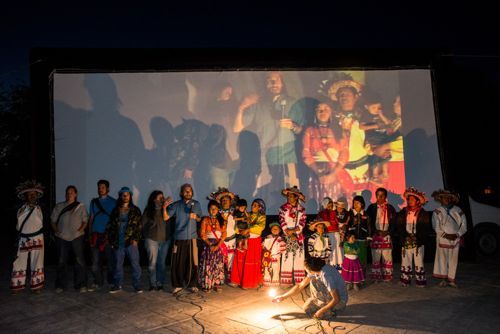FIRST OF TWO INTERVIEWS
See also: Interview with the Last Peyote Guardians: Marakame José Luis "Katira" Ramírez and son
When Argentine filmmaker Hernán Vílchez made his way up into the remote Wixarika community of San Andrés Cohamiata Tateikie high in the Western Sierra Madre of Mexico, he knew he would be entering another world. What he didn't know was how deeply it would change his own life.
The movie tells the story of the Wixarika or Huichol people, one of the most intact precolonial people remaining in the Americas, and their battle to save the sacred site upon which their cosmovision depends from Canadian gold and silver mining operations. It's a story emblematic of a horrifically destructive industry at work all over the world, and at the same time unique to this time and place and culture, and it's a story that's very much alive.
Huicholes: The Last Peyote Guardians, a beautiful and profound new film just released on demand at www.huicholesfilm.com, breaks new ground on many fronts. First there was the making of the film, which revolves around the pilgrimage of a single family, that of the marakame or shaman José Luis Ramírez, or Katira by his Wixarika name, to the sacred desert of Wirikuta and to the Cerro Quemado, the Birthplace of the Sun. Other films have been made exploring the colorful and deeply spiritual traditions of the Wixarika people, but none that has covered with this level of depth and professionalism the spiritual traditions of this people and the existential threat that culture now faces.
The film crew, accompanied by numerous members of the Ramírez family, has also pioneered a new approach to distribution in an era of self-publishing and artistic independence. Rather than premiering the film at a prestigious film festival and then concentrating their efforts on audiences and festivals in major cities, the crew premiered the film in a way that most resembles the ancient Wixarika pilgrimage, but in reverse. The first two showings were in the pilgrimage destination, the threatened sacred site itself, the remote mountain range and desert valley of Wirikuta. The next stop was a two-day caravan up into the even more remote Wixarika territories. Only then did they take their tour to overflow crowds in Mexico's two largest cities, Guadalajara and Mexico City.
Now, due to the urgency of the message, they are trying to raise the money to go on tour with the movie: first, beginning in August, in South America, followed by Europe in September and October, and the U.S. and Canada in November.

Film director Hernán Vílchez introduces the film at its world premiere in Real de Catorce, in Wirikuta, the contested ceremonial territory of the Huichol people. (Credit: José Andrés Solórzano)
I caught up with the film's director, Hernán Vílchez, and producer, Paola Stefani, and Katira and his son Clemente at the producer's home in Mexico City recently as they recovered from the eight-day marathon. Here is the interview.
Hernán: We've just recovered from the Five Colors of Corn and Five Functions movie release tour, and the Ramírez family is here with us. The world premiere of Huicholes: The Last Peyote Guardians was very well received and really exceeded our expectations. We're feeling very grateful to the Mexican people but especially those who attended and also supported us. It's been three and a half years since I began this work, almost as a mandate from the Elder's Council of San Andrés Cohamiata. They asked me to do a film to tell the story of their struggle to save their most sacred site, and this is the result.
Tracy: Speaking of the movie release tour, let's talk about that first. What stood out the most for you as you traveled with this film, what surprised you, in terms of the way it was received? In particular, the different reactions of the very different audiences you were able to reach?
Paola: For us it was very important to take the film in the first place to Real de Catorce and to the populations of the desert, and likewise to the Huichol territories in the mountains. Our first interest is to take the film to the people who are affected by this conflict by the mine in Wirikuta, and so the first would be those who live in the desert, and of course to the Wixaritari.
As Hernán already said, the first response was to have in attendance more than 500 people, in Real de Catorce as in Estación Catorce and in the Huichol territories. In Guadalajara, we could never have imagined that 800 people would show up and that more than half would be left outside. So obviously Wirikuta is a subject that interests many people. In Mexico City, where there was a last-minute change of venue and then it rained, about 2,500 people turned out - and what was very moving also is that the majority were young people.
In the case of the Guadalajara function, there was an enormous diversity in the kinds of people who came. I think the public response - it was a very quick tour, no? In eight days we did five events and traveled more than 2,700 kilometers. So we didn't have the opportunity to stay for a long time in each place after the function but immediately after finishing the film what we most received were words of profound thanks; in Estación Catorce we were talking to kids between 16 and 18 years old, and they were saying, 'We've always seen the Wixaritari with their pilgrimages and we've never really understood what it was about; now we understand.'"
In Real de Catorce we had the chance to speak with ejidatarios (collective landowners, mostly small farmers) from the mountains as well as the valley, and they were grateful to be able to have access to serious information, and also something that kept coming up in the comments was the importance of making it very clear that the Wixárika people have no intention of depriving anyone of their land or their ability to make a living. One of the comments too was that it was really touching for many inhabitants of Wirikuta that the Wixárika people were there, looking in their eyes concerning the effects of the mining on their territory and how it would affect the water.
In Mexico City the film ended with a light sprinkling of rain (considered as a benediction among the Wixárika people and their supporters) and applause and shouts of Viva Wirikuta, very moving as well. I think if it hadn't rained as it did, I think we could have ended up with 5,000 people. It's not the film, it's the subject; I think the people are really sensitized to the subject of Wirikuta.
Read the full interview at Intercontinental Cry.
The film can be viewed online for $3.99 at huicholesfilm.com.
Anyone who is interested in organizing a film screening or supporting the effort may contact the director at hernanton@gmail.com.
